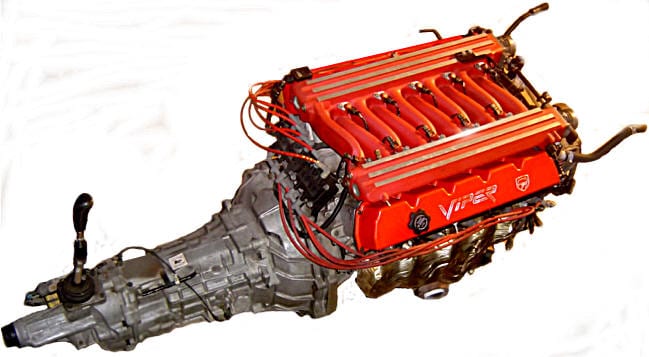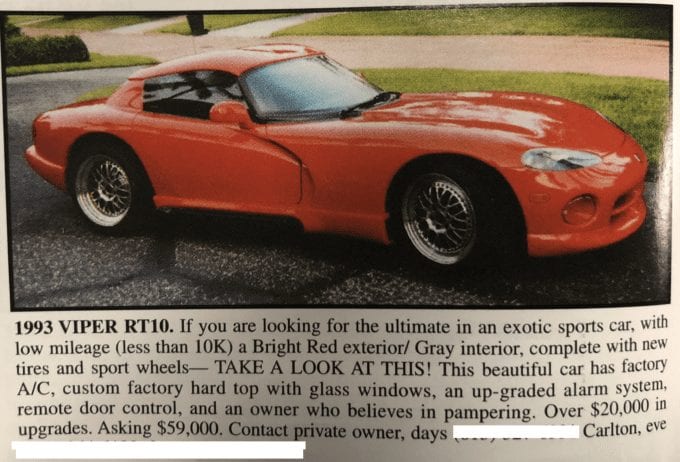In the late 1980s, automotive engineers started to realize that high-performance cars could meet emissions standards, and advancements in technology led to the 1991-1995 Dodge Viper R/T 10 Roadster for sale. Lee Iaccoca was the big boss at Chrysler, responsible for taking a bankrupt business and making it a world leader. After the Minivan, K-Cars, and the LeBaron exceeded expectations, he was ready to retire with a bang. Calling an old friend, Carroll Shelby agreed to help him build a Cobra for the 90’s. Starting in 1988, they began work on a 2-seat roadster. Once it was ready for production, Mr. Shelby showed off its abilities as the Pace Car for the 1991 Indy 500.
1991-1995 Dodge Viper RT/10 Price
Every Dodge Viper has been built by hand at the Mack Avenue Assembly Plant. The first-generation cars are known as SR1 among owners, and the 1991 Dodge Viper RT/10 Roadster MSRP was $52,000. This included the federal gas guzzler tax and adjusted for inflation, a new 1992 Dodge Viper RT/10 Roadster for sale would be worth just over $97,070 in the summer of 2020. Because the car was unlike anything on the road, dealers were marking them up to $100,000, making incredible profits due to the limited demand.

1991-1995 Dodge Viper RT/10 Roadster Review
In order to understand what an SR1 Viper was truly like, you need to spend some time at a race track. Every aspect of the design and function of the 1991-1995 Viper was for performance. Driving is incredibly fun, but sacrifices to civility are plenty. The pedal box is off-center due to the massive engine, therefore your feet must learn a new three-pedal dance. The side pipe exhaust exits just below your ears, and since it has no crossover, you get a unique blast of an inline 5-cylinder. The suspension is tuned to grip at triple-digit speeds, so some consider it brutal. You will need to find smooth pavement and avoid reflectors.
7:01 Viper’s Return to the Green Hell
The flywheel is light, so you will stall it a few times. That is because every Dodge Viper for sale used the same six-speed manual transmission. The Borg-Warner T56 is bulletproof and featured double overdrives for highway cruising. You won’t be distracted by modern annoyances because the 1991-1995 Dodge Viper RT/10 Roadster doesn’t have a few things you might like. Things like Air Conditioning, airbags, traction control and anti-lock brakes were not offered. Eisenglass windows could be zipped into place, and the roof was convertible top fabric. It has tons of grip and 460 lb-ft of torque, so every 1991-1995 Dodge Viper must be treated with respect.

1991-1995 Dodge Viper RT/10 Roadster Specs
While many believe the body panels are fiberglass, the 1991-1995 Dodge Viper RT/10 Roadster Specs begin with Kevlar and Carbon Fiber. Dodge had just purchased Lamborghini, and the sharing of knowledge allowed the Viper specs to be lighter and stronger than its competitors. This is why the 1991-1995 Dodge Viper RT/10 Roadster 0-60 is 4.5 seconds. Due to the lack of a roof or proper windows, the 1991-1995 Dodge Viper RT/10 top speed is 165 mph. Nevertheless, the 1/4 mile could be achieved in mid to low 12-second times with a skilled driver.
Then & Now: First Generation Dodge Viper
Dodge Viper Specs
- Price: Starting $52,000
- Engine: 8-litre V10
- Transmission: 6-speed manual
- Horsepower: 400 hp
- Torque: 465 lb-ft
- 0-60 mph: 4.5 seconds
- 1/4 mile: 12.6 seconds @ 114 mph
- Top Speed: 165 mph
- Weight: 3,285 lbs

1991-1995 Dodge Viper RT/10 Roadster Engine
Engineers at Chrysler wanted 10 cylinders to make the 1991-1994 Dodge Viper RT/10 Roadster engine. Instead of starting from scratch, early prototypes were based on the 5.9-liter Magnum. The stroke was increased to 3.88 and two cylinders were added to reach 7.99 liters. While a V10 engine would be ideally balanced at 72 degrees, this would require extensive revisions to the block and heads. That is why each 1991-1995 Dodge Viper RT/10 Roadster has 90 degrees of cylinder separation. This requires an odd firing order to maintain balance. It also endows the Viper with a unique exhaust note, as it lacks a crossover tube between the manifolds. It was a revolutionary design that was also used in other Dodge products later on.

1991-1995 Dodge Viper RT/10 Roadster Transmission
The immense torque and lightweight of the 1991-1995 Dodge Viper RT/10 Roadster required six gears to achieve decent fuel mileage. While this could have been done by ZF, they turned to Borg-Warner to commission an all-new six-speed. The 1991-1995 Dodge Viper RT/10 Roadster would benefit from triple-cone synchronizers, steel shift forks, and an electrical lockout of reverse gear. The design was taken over by Tremec, who still produces an improved version nearly 3 decades later. Many enthusiasts don’t realize the 1991-1995 Dodge Viper RT/10 Roadster has a differential ratio of 3.07. Even a subtle upgrade to 3.55 or 4.10 will provide a healthy increase to rear-wheel torque.

1991-1995 Dodge Viper RT/10 Roadster Interior
In keeping with American roadster traditions, the first 1991-1995 Dodge Viper RT/10 Roadster interiors were spartan to say the least. Air Conditioning was not an option on the early cars, and the audio system was an FM cassette deck. Storage space is at a minimum, and the cramped footwells reach over 100 degrees thanks to the catalytic converters. The seats are very comfy with deep bolsters, but the steering column is not adjustable. The only windows are temporary Isinglass protectors that zip into place. The only auxiliary switches are for the fog lights, and the white face gauges will strain your eyes on a dark night.
Sell My Dodge Viper: Get a Cash Offer

1991-1995 Dodge Viper RT/10 Roadster Standout Features
Compiling what is unique about the 1991-1995 Dodge Viper RT/10 Roadster can best be done by addressing what is missing. You will not have ABS, so threshold braking is the only way to stop. No traction or stability controls put you in control of your destiny. With early cars devoid of roof panels or windows, you might want to stick to sunny days. Because the engine is externally balanced, the offset weight of the flywheel will take some getting used to. Because it is a pushrod engine with overhead valves, there are many companies that offer upgrades to all systems. While they were massive at the time, the 275/40 ZR 17 (Front) & 335/35 ZR 17(Rear) tires are quite common and affordable. Other maintenance like brakes and oil changes are also inexpensive, which makes the 1991-1995 Dodge Viper RT/10 Roadster a bargain among its contemporaries.











